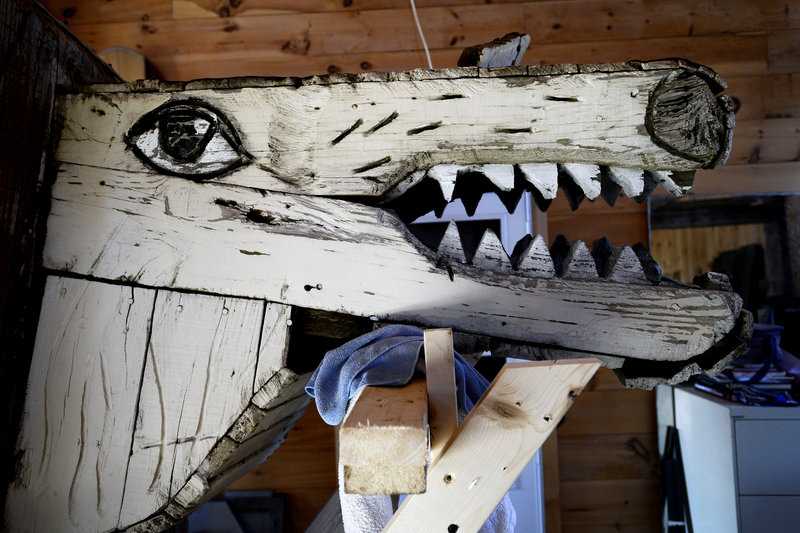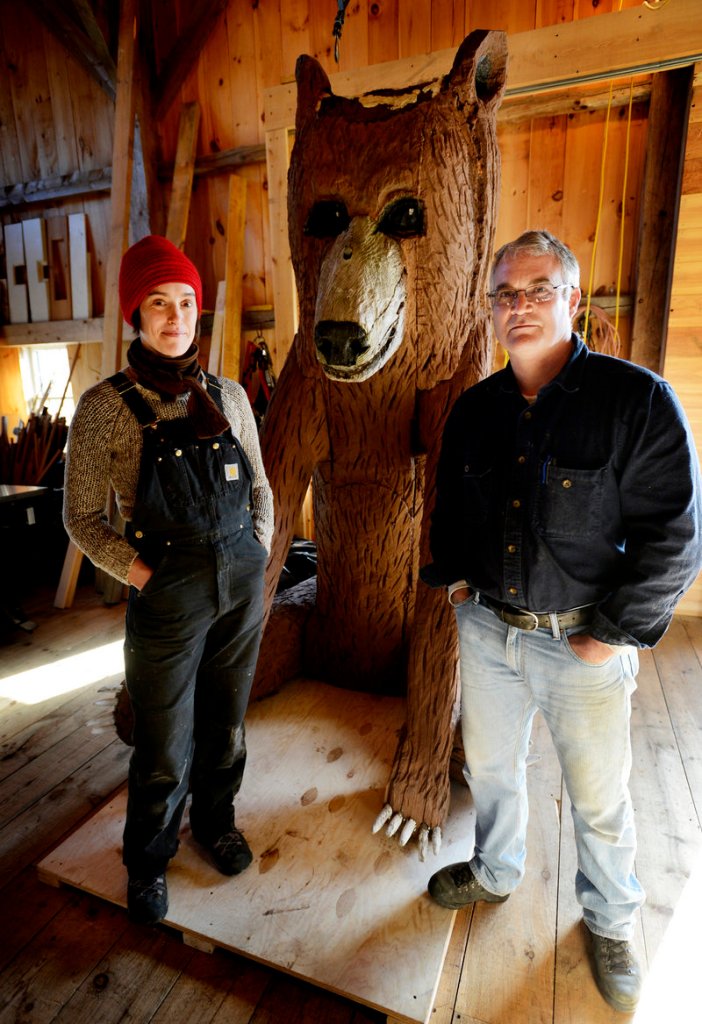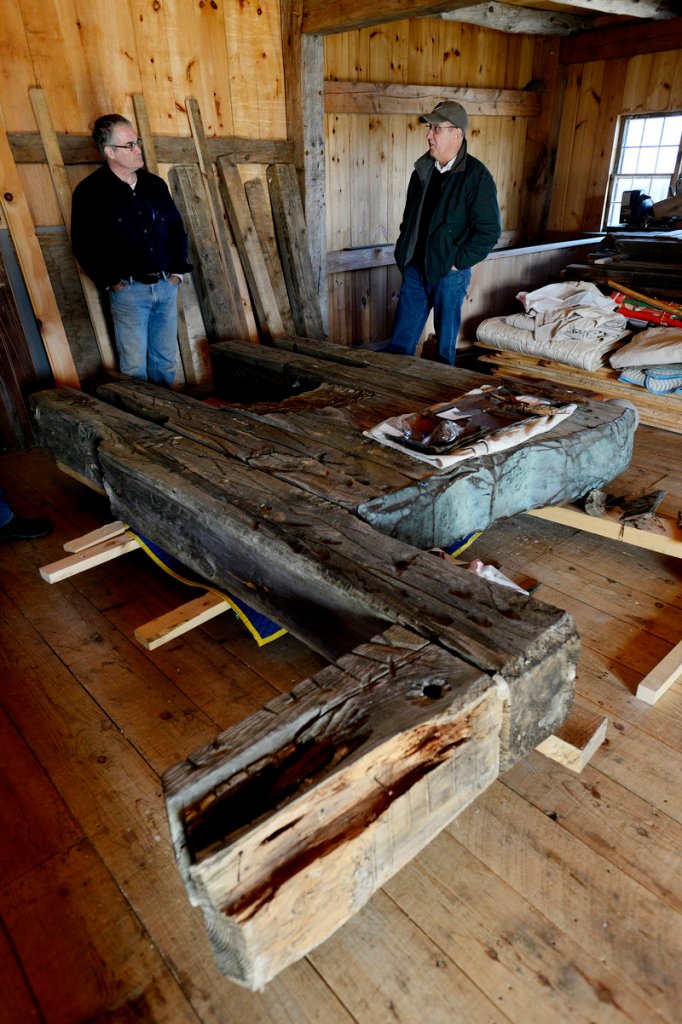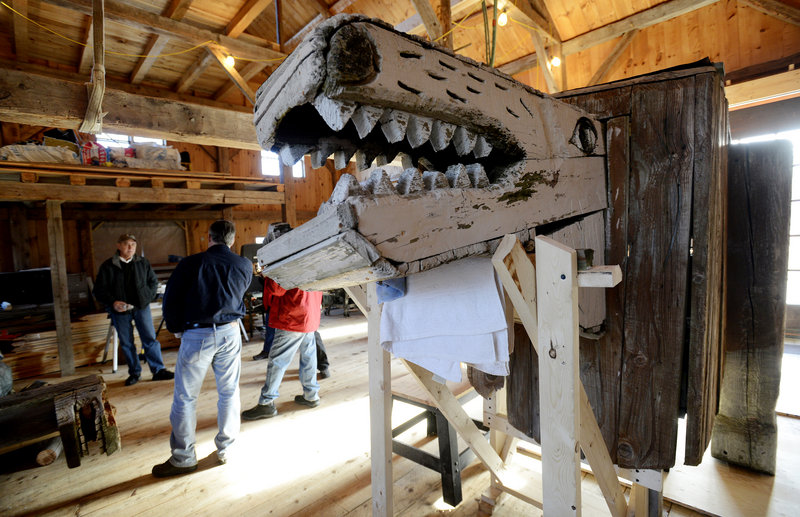BERWICK — Arron Sturgis preserves church steeples, barns and old New England homes.
Anything with timber frames, he tackles.
This winter, Sturgis and his crew at Preservation Timber Framing Inc. in Berwick take on a project of lesser scope but with equal or greater cultural significance. Sturgis is working with the Ogunquit Museum of American art to conserve and preserve three large wooden sculptures by the late Maine artist Bernard Langlais.
The pieces — a bear, a lion and a horse, each weighing up to a half-ton — have lived outside in the museum’s sculpture garden since the museum acquired them over the course of three decades beginning in the late 1960s. They have weathered all that the Maine outdoors can bring, from freezing rain and snow to ocean gales and scorching summer sun.
But they have not weathered the elements well.
The pieces, which Langlais made at his Cushing studio in the 1960s and ’70s, are in various stages of decay. They suffer from rot, degradation and general neglect, although the museum has made efforts over the years to keep up with their considerable needs.
But only recently, thanks to grants from the Bernard Langlais Fund, has the museum had the financial means to hire someone with the expertise to do the job right. The museum received $10,000 from the fund, which is administered by the Maine Community Foundation, and raised another $10,000 to match it.
The fundraising continues. Museum director Ron Crusan hopes to garner up to another $10,000 to ensure completion of the project by the spring.
On Friday, the museum received a $5,000 grant from the Warren Memorial Foundation of Westbrook to help complete the effort.
Sturgis and his crew will spend their winter working to return these sculptures to a dignified state.
“The challenge is doing this work without changing the artifact so it’s no longer a Langlais,” said Sturgis, who has extensive museum experience, including at the Museum of Fine Arts in Boston and Fogg Museum at Harvard University in Cambridge. “But they’re all salvageable, and they all will be Langlais when we’re done with them.”
The bear may be in the worst shape. He is full of rot, and previous efforts to stem the rot with spray foam hastened the animal’s decline, because the stopgap measure had the unintended effect of trapping water.
The lion is in better shape. Its internal supporting structure has deteriorated, causing it to pitch forward. But that support structure will be rebuilt. The outer shell is mostly fine.
The horse has sustained rot as well, particularly along his angular face. Parts of his legs have been replaced over the years. Sturgis will rebuild him to his original height and structure based on old photos.
The problem that Ogunquit faces is not unique. Langlais sculptures are all over Maine. The Maine native made hundreds of pieces after returning to his home state in the 1960s. He died 35 years ago this month at age 56.
Langlais’ best-known piece is a 62-foot-tall Indian in Skowhegan. The University of Maine Presque Isle owns a 35-foot owl, and has similarly raised money privately and through the Langlais fund to save it.
The artist, who was better known by his nickname “Blackie,” became known for his large works that included figurative outdoor wooden sculptures. The pieces that Ogunquit owns are big, but manageable.
The horse stands 10 feet tall and weighs somewhere around 1,000 or 1,200 pounds. The bear is 8 feet tall, and the lion roars at a little more than 7 feet.
A FOURTH animal sculpture, a rhinoceros, is coming to Ogunquit soon, courtesy of the University of Southern Maine. The rhino has met an ill fate on the Gorham campus, vandalized and occupied by students for illicit purposes.
It will have a safer, more dignified home at Ogunquit, Crusan said.
When Sturgis finishes his work and the trio of beasts returns to Ogunquit, the museum will re-imagine its sculpture garden. The Langlais pieces may be moved from their former locations and re-sited with new pads and footings to minimize rot.
Sturgis laughs when recalling his journey from Ogunquit to his workshop in Berwick. The cavalcade of animals turned a few heads along the way. But he grimaces when he recalls humping these beasts into his studio, and cannot imagine the artist’s struggle with these sculptures when he constructed them.
When he rebuilds a church steeple, the craftsman sits in the sanctuary to absorb the aura of the building. He gleans a lot just by looking. He learns something about the builder’s aesthetic and techniques.
Strugis does the same thing with these sculptures. He’s spending a lot of time simply observing how Langlais put them together, how he made his mark on them and what his thought process might have been. That information, which involves equal parts detective work and expertise, will help him make good decisions about how the art can be best conserved and preserved.
“I’m trying to get inside his brain,” said Sturgis. “One thing I’ve learned, this guy wasn’t wasting any time on these. These aren’t pieces of finely crafted furniture. He was really moving.”
Sturgis makes that observation with affection. He didn’t know Langlais, but he thinks they would have enjoyed each other’s company. They would have had a lot in common and shared similar interests.
Sturgis is 52, a similar age as Langlais when the artist was in his creative prime. He can imagine how Langlais worked. He envisions the artist gathering timbers and discarded materials from the stacks that he kept at Cushing and assembling these pieces with whimsy, humor and passion.
AS HE DELVES INTO this project, Strugis wants to capture that same spirit and approach his work with the same vigor that he imagines Langlais employed.
By studying the marks in the wood, he can measure the gauge of the chain that Langlais used on his saws when he made his cuts and marks. He smirks knowingly as he notes a chainsaw mark on the head of a bolt on the bear. He imagines Langlais’ choice words when the saw kicked on impact.
Sturgis will use the same tools and techniques when he saws new wood to match the old. And he will do his best to use the exact same materials as Langlais, down to the lag bolts and nails.
Langlais was born in Old Town in 1921. He had success in New York as a painter and maker of smaller wooden objects.
He and his wife, Helen, returned to Maine in the late 1960s, settling in Cushing, where he made most of his larger, iconic pieces.
He was part of a large group of artists who came to Maine in the 1960s and settled in the midcoast. His circle included Alex Katz, Charlie DuBack, Lois Dodd and others. He was one of the founders of Maine Coast Artists in Rockport, now known at the Center for Maine Contemporary Art.
Langlais was known nationally, but not at a level of Katz or Andrew Wyeth, another Cushing-area artist. But he looms large in Maine, and remains a central figure in the state’s contemporary art scene.
Like modernist painter Marsden Hartley, Langlais understood the working-class aesthetic of his native state better than most. He attended the Skowhegan School of Painting and Sculpture during its early heyday, and went to New York to make his living.
His work reflects both his roots and his sophistication, said Portland gallery owner Andres Verzosa, who began the Langlais fund and has championed his work in recent years.
Verzosa could not be happier that these pieces are finally getting attention.
“This is better than Christmas,” he said, beaming as he stood in the middle of Sturgis’ workshop. “For a long time, I would see these at the museum and see what shape they were in.
“This is what it’s all about. This is why we raised the money.”
Staff Writer Bob Keyes can be reached at 791-6457 or:
bkeyes@pressherald.com
Twitter: pphbkeyes
Send questions/comments to the editors.








Success. Please wait for the page to reload. If the page does not reload within 5 seconds, please refresh the page.
Enter your email and password to access comments.
Hi, to comment on stories you must . This profile is in addition to your subscription and website login.
Already have a commenting profile? .
Invalid username/password.
Please check your email to confirm and complete your registration.
Only subscribers are eligible to post comments. Please subscribe or login first for digital access. Here’s why.
Use the form below to reset your password. When you've submitted your account email, we will send an email with a reset code.